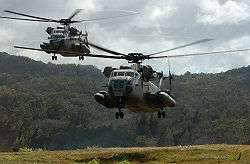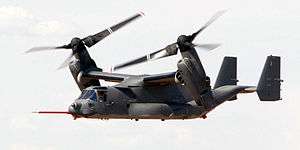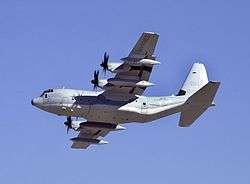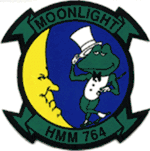List of active United States Marine Corps aircraft squadrons
This is a list of all of the active squadrons that exist in the United States Marine Corps, sorted by type. Most squadrons have changed names and designations many times over the years, so they are listed by their current designation.
- To see Marine Aviation units sorted by command hierarchy, see aviation combat element.
Squadron designations
The basic tactical and administrative unit of United States Marine Corps aviation is the squadron. Fixed-wing aircraft squadrons (heavier than air) and tiltrotor squadrons are denoted by the letter "V", which comes from the Spanish verb "volar" (to fly). Rotary wing (helicopter) squadrons use "H." Marine squadrons are always noted by the second letter "M." Squadron numbering is not linear as some were numbered in ascending order and others took numbers from the wing or the ship to which they were assigned. From 1920 to 1941, Marine flying squadrons were identified by one digit numbers. This changed on July 1, 1941 when all existing squadrons were redesignated to a three-digit system. The first two numbers were supposed to identify the squadrons parent group but with the rapid expansion during World War II and frequent transfer of squadrons this system fell apart.[1]
Rotary-wing aircraft
Marine Helicopter Squadron
The squadron is responsible for the helicopter transportation of the President of the United States, Vice President, Cabinet members and VIPs. In addition to its VIP transport role, it is also tasked with operational test and evaluation (OT&E) of new flight systems for Marine Corps helicopters.[2] The squadron flies the VH-3D Sea King the VH-60N Whitehawk, and the MV-22 Osprey. These were due to be replaced by the VH-71 Kestrel,[3] however that program was cancelled in April 2009.[4] Lastly, HMX-1 provides support to training at The Basic School, providing aerial insertion for various training events, as well as MAGTF Air component orientation to the student officers.
| Squadron Name | Insignia | Nickname | Date Commissioned | Senior Command | Station |
|---|---|---|---|---|---|
Marine Heavy Helicopter Squadrons
Heavy helicopter squadrons were first formed in 1966 when the Marine Corps began flying the heavy lift CH-53 Sea Stallion during the Vietnam War.[6] Their primary role is moving cargo and equipment with the secondary role of transferring troops ashore in an amphibious assault. All squadrons have transitioned from the CH-53 Sea Stallion to the larger and more powerful CH-53E Super Stallion.[7] The CH-53Es are the most powerful helicopter in the U.S. military inventory today.[8] Due to a reorganization in Marine aviation, HMH-366 was reactivated in 2008[9] at MCAS Cherry Point.[10]


| Squadron Name | Insignia | Nickname | Date Commissioned | Senior Command | Station |
|---|---|---|---|---|---|
 |
|||||
Marine Heavy Helicopter Training Squadron
The squadron trains newly designated (i.e., winged) Naval Aviators, conversion pilots, refresher pilots, and enlisted aircrew on the CH-53E Super Stallion.[16]
| Squadron Name | Insignia | Nickname | Date Commissioned | Senior Command | Station |
|---|---|---|---|---|---|
Marine Light Attack Helicopter Squadrons
The Marine Corps’ light attack squadrons are composite squadrons made up of 18 AH-1W SuperCobras or AH-1Z Vipers and 9 UH-1Y Venoms.[17] The primary missions of the Cobra is close air support, forward air control, reconnaissance and armed escort,[18] while the Huey provides airborne command and control, utility support, supporting arms coordination and medical evacuation.[19] The AH-1W is due to be upgraded to the AH-1Z Viper as part of the H-1 upgrade program which will see both the AH-1 and UH-1 get greater power, improved avionics and an 85% commonality of parts.[20][21][22] The transition to the UH-1Y was completed in August 2014 when HMLA-773 flew the UH-1N for the last time.[23] Due to the need for more light attack squadrons, the Marine Corps began adding new squadrons in 2008.[24] HMLA-467 and HMLA-469 are the newest squadrons. However, as a result of force structure reductions, HMLA-467 is scheduled to be deactivated by the end of FY16[10]

| Squadron Name | Insignia | Nickname | Date Commissioned | Senior Command | Station |
|---|---|---|---|---|---|
Marine Light Attack Helicopter Training Squadron
The squadron trains newly designated (i.e., winged) Naval Aviators, conversion pilots, refresher pilots, and enlisted aircrew on the AH-1W SuperCobra, the UH-1Y Venom, as well as transition to the newer AH-1Z Viper variant.[33]
| Squadron Name | Insignia | Nickname | Date Commissioned | Senior Command | Station |
|---|---|---|---|---|---|
Tiltrotor Aircraft
Marine Medium Tiltrotor Squadrons
Marine tiltrotor squadrons are new units operating the MV-22 Osprey with their main mission being assault support. The Osprey offers twice the speed, five times the range, and can fly more than twice as high as the helicopters it is replacing.[34] As the Marine Corps’ number one aviation acquisition priority, the Osprey is replacing the aging fleet of CH-46 Sea Knight helicopters and is a cornerstone of the capstone concept of Expeditionary maneuver warfare.[35] As of July 2015, the Marine Corps has 13 Fully Operationally Capable (FOC) MV-22 squadrons. VMM-268, VMM-364, and VMM-164 will reach FOC in FY16. The two newest Osprey squadrons, VMM-362 and VMM-212, will stand up in FY18 and FY19 respectively, completing the Marine Corps' transition to 18 active component MV-22 squadrons. Each squadron operates 12 aircraft.

Marine Medium Tiltrotor Training Squadron
The squadron provides new and conversion training to both Marine Corps and Air Force pilots and units in the use and maintenance of the Osprey tiltrotor aircraft.[53]
| Squadron Name | Insignia | Nickname | Date Commissioned | Senior Command | Station |
|---|---|---|---|---|---|
Fixed-Wing Aircraft
Marine Attack Squadrons
After World War II, the United States Navy decided to combine all of the functions of the scout bomber, torpedo bomber and bomber torpedo communities into the Attack designation.[54] On July 22, 1946, it released Bulletin No. 46-1543, which authorized the formation of attack squadrons; however, the Marine Corps did not form any until 1952.[1] Today, Marine attack squadrons fly the AV-8B Harrier II[55] and are tasked with providing close air support, air interdiction, surveillance and escort of helicopters. Because the STOVL Harrier can operate from amphibious assault ships, expeditionary airfields and tactical remote landing sites, it provides commanders with more flexibility in providing air support.[56] The Harrier is due to be replaced by the F-35B, the STOVL version of the F-35 Lightning II.[57] This transition began in 2016 when VMA-211 exchanged its Harriers for the F-35B and became VMFA-211.
_Air_Combat_Element_(ACE).jpg)

| Squadron Name | Insignia | Nickname | Date Commissioned | Senior Command | Station |
|---|---|---|---|---|---|
Marine Attack Training Squadron
The squadron trains newly designated (i.e., winged) Naval Aviators to fly the AV-8B Harrier II.[62]
| Squadron Name | Insignia | Nickname | Date Commissioned | Senior Command | Station |
|---|---|---|---|---|---|
Marine Tactical Electronic Warfare Squadrons
VMAQ squadrons operate the EA-6B Prowler[63] and are tasked with providing electronic attack, electronic counter-countermeasures, radar jamming and suppression of enemy air defense using the AN/ALQ-99 jamming pod[64] and the AGM-88 HARM. Each of the four squadrons operates five aircraft and are land-based, although they are capable of landing on board U.S. Navy aircraft carriers.[65][66] The Marine Corps has recently solidified plans to install a next-generation jammer on the F-35 Lightning II. It has joined the EA-18G Growler as the launch platform for the jammer, which is scheduled to enter service in 2018.[67]

| Squadron Name | Insignia | Nickname | Date Commissioned | Senior Command | Station |
|---|---|---|---|---|---|
 |
Marine Fighter Attack Squadrons
The Marine Corps' VMFA squadrons fly the single seat F/A-18A++, F/A-18C/C+ Hornet and F-35B Lightning II. Their primary role is to intercept and destroy enemy aircraft and to attack and destroy surface targets in all weather conditions. Each Hornet squadron operates 12 aircraft, each F-35B squadron operates 16 aircraft, and each F-35C squadron will operate 12 aircraft.[72][73] [74]

.jpg)
| Squadron Name | Insignia | Nickname | Aircraft | Date Commissioned | Senior Command | Station |
|---|---|---|---|---|---|---|
Marine All-Weather Fighter Attack Squadrons
The VMFA(AW) squadrons fly the two seat F/A-18D Hornet. Their primary mission is to attack and destroy surface targets, day or night, under all weather conditions; conduct multi-sensor imagery reconnaissance; provide supporting arms coordination; and intercept and destroy enemy aircraft in all weather conditions. The current F/A-18s saw their first action in Operation Desert Storm after replacing the venerable F-4 Phantom II.[72][73]
| Squadron Name | Insignia | Nickname | Date Commissioned | Senior Command | Station |
|---|---|---|---|---|---|
Marine Fighter Attack Training Squadrons
VMFAT-101 trains newly designated (i.e., winged) Naval Aviators to fly the F/A-18 Hornet while VMFAT-501 trains new and transitioning pilots to fly the F-35B Lightning II.[89][90]
| Squadron Name | Insignia | Nickname | Date Commissioned | Senior Command | Station |
|---|---|---|---|---|---|
Marine Fighter Training Squadron
VMFT-401 is the only aggressor squadron in the Marine Corps. It flies the F-5E Tiger II and provides instruction to active and reserve squadrons through dissimilar adversary combat tactics. The squadron is based at Marine Corps Air Station Yuma, AZ and is assigned to Marine Aircraft Group-41, 4th Marine Aircraft Wing, Marine Forces Reserve.
Marine Aerial Refueler Transport Squadrons
VMGR squadrons operate the KC-130 Hercules tanker/transport. Their primary missions are aerial and rapid ground refuelling, transportation of personnel and cargo to include MEDEVACs and parachute insertions, flying the airborne version of the Direct Air Support Center (DASC) and emergency resupply into unimproved landing zones.[91][92][93]

| Squadron Name | Insignia | Nickname | Aircraft | Date Commissioned | Senior Command | Station |
|---|---|---|---|---|---|---|
Marine Transport Squadron
VMR squadrons provide search and rescue support as well as movement of key personnel and critical logistics support around the world. They also provide movement of high priority passengers and cargo during wartime in support of operations and other critical commitments.[99]

| Squadron Name | Insignia | Nickname | Date Commissioned | Senior Command | Station |
|---|---|---|---|---|---|
Marine Operational Test and Evaluation Squadron
The squadron is a Marine Corps test and development unit. Its mission is to conduct operational testing and evaluation of Marine Corps fixed, tiltrotor, and rotary-wing aircraft. The unit was redesignated to VMX-1 (from VMX-22) on May 13, 2016.[100]
| Squadron Name | Insignia | Nickname | Aircraft | Date Commissioned | Senior Command | Station |
|---|---|---|---|---|---|---|
AH-1W/Z CH-53E/K MV-22B F-35B RQ-21 |
Unmanned Aerial Systems
Marine Unmanned Aerial Vehicle Squadrons
VMUs operate the RQ-7B Shadow unmanned aerial system (UAS) which provides Marine ground forces with reconnaissance, surveillance, and target acquisition. They also provide artillery spotting and can assist in search and rescue operations.[101][102] Since 2004, the VMU squadrons have also been operating the Boeing ScanEagle UAS, and has longer endurance and smaller footprint, but has a lesser camera capability with no IR pointer.[103] The Navy/Marine Corps has shown interest in the MQ-8B Fire Scout Vertical Takeoff and Landing Tactical Unmanned Aerial Vehicle (VTUAV),[104] which was originally developed to meet the future Tier III requirements of the Marine Corps.[105] Due to the high operational tempo of the VMU squadrons in recent years, the Marine Corps stood up VMU-3 in 2008 and VMU-4, a reserve unit, was activated in 2010 with the lineage of VMO-4.[24]

| Squadron Name | Insignia | Nickname | Date Commissioned | Senior Command | Station |
|---|---|---|---|---|---|
See also
- United States Marine Corps Aviation
- Aviation combat element
- List of inactive United States Marine Corps aircraft squadrons
- List of United States Marine Corps aircraft groups
- List of United States Marine Corps aircraft wings
- List of United States Marine Corps aviation support units
- List of United States Marine Corps battalions
References
- 1 2 Rottman, Gordon L. (2002). U.S. Marine Corps World War II Order of Battle – Ground and Air Units in the Pacific War. Westport, Connecticut: Greenwood Press. ISBN 0313319065.
- ↑ "Marine Helicopter Squadron One". The White House. United States Government. Retrieved 2007-02-28.
- ↑ "History of the Executive Flight Detachment". Marine Helicopter Squadron One. United States Marine Corps. Archived from the original on 2017-02-03. Retrieved 2009-10-26.
- ↑ http://www.msnbc.msn.com/id/30071664/
- ↑ "Marine Helicopter Squadron One". United States Marine Corps. Retrieved 2009-10-26.
- ↑ Weiss, Alan. "Sikorsky CH-53 Sea Stallion". The Flying Tigers of HMR, HMM, HMH 361. Retrieved 2007-02-28.
- ↑ "From Vietnam To Afghanistan – End Of An Era For An Icon Of Marine Aviation". http://www.aero-news.net/. Retrieved 2014-10-03. External link in
|publisher=(help) - ↑ "CH-53E / S-80E Super Stallion Helicopter". Sikorsky. Archived from the original on October 16, 2006. Retrieved 2007-03-26.
- ↑ Wilson, Drew C (30 August 2008). "New squadron takes flight at Cherry Point". Havelock News. Freedom Communications, Inc. Retrieved 2008-08-30.
- 1 2 Barton, Mike (10 July 2008). "Helicopters bring new training to MCAS Cherry Point". Marine Corps Air Station Cherry Point. United States Marine Corps. Archived from the original on July 14, 2008. Retrieved 2008-07-13.
- ↑ "Marine Heavy Helicopter Squadron 361". Marine Aircraft Group 16. United States Marine Corps. Retrieved 2007-03-16.
- ↑ "Marine Heavy Helicopter Squadron 461". Marine Aircraft Group 29. United States Marine Corps. Retrieved 2008-12-05.
- ↑ "Marine Heavy Helicopter Squadron 462". Marine Aircraft Group 16. United States Marine Corps. Retrieved 2007-03-16.
- ↑ "Marine Heavy Helicopter Squadron 463". Marine Aircraft Group 24. United States Marine Corps. Retrieved 2007-03-16.
- ↑ "Marine Heavy Helicopter Squadron 464". Marine Aircraft Group 29. United States Marine Corps. Retrieved 2007-03-16.
- ↑ "Marine Helicopter Training Squadron 302". Marine Aircraft Group 29. United States Marine Corps. Retrieved 2008-12-05.
- ↑ "MCRP 5-12D Organization of Marine Corps Forces". United States Marine Corps. Retrieved 2014-11-02.
- ↑ "UH-1 Huey Helicopter". Military Analysis Network. Federation of American Scientists. 1999-03-12. Retrieved 2007-03-27.
- ↑ "AH-1W Super Cobra AND UH-1N Huey". Naval Historical Center. United States Navy. Retrieved 2007-03-26.
- ↑ "The Bell AH-1Z". Bell Helicopter. Archived from the original on 2007-03-28. Retrieved 2007-03-26.
- ↑ "The Bell UH-1Y". Bell Helicopter. Archived from the original on 2007-04-03. Retrieved 2007-03-26.
- ↑ "United States Marine Corps – 2005 – Concepts + Programs" (PDF). Headquarters Marine Corps. 2005. Archived from the original (PDF) on 2007-01-01. Retrieved 2007-02-28.
- ↑ http://www.marines.mil/News/NewsDisplay/tabid/3258/Article/496683/final-flight-of-huey-for-red-dogs.aspx
- 1 2 LtGen George J. Trautman, III (2009). "2010 Marine Aviation Plan" (PDF). Headquarters Marine Corps. Archived from the original (PDF) on March 31, 2010. Retrieved 2010-01-05.
- ↑ "Marine Light Attack Helicopter Squadron 167". Marine Aircraft Group 26. United States Marine Corps. Retrieved 2008-12-05.
- ↑ "Marine Light Attack Helicopter Squadron 169". Marine Aircraft Group 39. United States Marine Corps. Retrieved 2007-03-16.
- ↑ "Marine Light Attack Helicopter Squadron 267". Marine Aircraft Group 39. United States Marine Corps. Retrieved 2007-03-16.
- ↑ "Marine Light Attack Helicopter Squadron 269". Marine Aircraft Group 29. United States Marine Corps. Retrieved 2007-03-16.
- ↑ "Marine Light Attack Helicopter Squadron 367". Marine Aircraft Group 39. United States Marine Corps. Retrieved 2007-03-16.
- ↑ "Marine Light Attack Helicopter Squadron 369". Marine Aircraft Group 39. United States Marine Corps. Retrieved 2007-03-16.
- ↑ "Marine Light Attack Helicopter Squadron 469". Marine Aircraft Group 39. United States Marine Corps. Retrieved 2009-05-18.
- ↑ "Marine Light Attack Helicopter Squadron 773". Marine Aircraft Group 42. United States Marine Corps. Archived from the original on 2010-07-15. Retrieved 2010-08-09.
- ↑ "Marine Light Attack Helicopter Training Squadron 303". Marine Aircraft Group 39. United States Marine Corps. Retrieved 2007-03-16.
- ↑ "The Bell-Boeing V-22". Bell Helicopter. Retrieved 2007-03-26.
- ↑ "Statement of Lieutenant General Emil R. Bedard, Deputy Commandant Plans, Policies & Operations before the Senate Armed Services Committee — April 9, 2003". U.S. Marine Corps. Retrieved 2007-02-28.
- ↑ "Marine Medium Tiltrotor Squadron 161". Marine Aircraft Group 16. United States Marine Corps. Retrieved 2009-12-18.
- ↑ "Marine Medium Tiltrotor Squadron 162". United States Marine Corps. Retrieved 2007-03-16.
- ↑ "Marine Medium Tiltrotor Squadron 163". Marine Aircraft Group 16. United States Marine Corps. Retrieved 2007-03-16.
- ↑ "Marine Medium Tiltrotor Squadron 165". United States Marine Corps. Retrieved 2007-03-16.
- ↑ "Marine Medium Tiltrotor Squadron 166". United States Marine Corps. Archived from the original on March 10, 2007. Retrieved 2007-03-16.
- ↑ "Marine Medium Tiltrotor Squadron 261". United States Marine Corps. Retrieved 2008-05-25.
- ↑ "Marine Medium Tiltroter Squadron 262". United States Marine Corps. Retrieved 2007-03-16.
- ↑ "Marine Medium Tiltrotor Squadron 263". United States Marine Corps. Retrieved 2007-03-16.
- ↑ "Marine Medium Tiltrotor Squadron 264". United States Marine Corps. Retrieved 2009-06-18.
- ↑ "Marine Medium Tiltrotor Squadron 265". United States Marine Corps. Retrieved 2007-03-16.
- ↑ "Marine Medium Tiltrotor Squadron 266". United States Marine Corps. Retrieved 2007-03-26.
- ↑ "Marine Medium Tiltrotor Squadron 268". United States Marine Corps. Retrieved 2007-03-26.
- ↑ "Marine Medium Tiltrotor Squadron 363". United States Marine Corps. Retrieved 2007-03-26.
- ↑ "Marine Medium Tiltrotor Squadron 364". United States Marine Corps. Retrieved 2014-11-02.
- ↑ "Marine Medium Tiltrotor Squadron 365". United States Marine Corps. Retrieved 2009-02-13.
- ↑ "Marine Medium Helicopter Squadron 764". United States Marine Corps. Archived from the original on March 10, 2007. Retrieved 2007-03-16.
- ↑ "Marine Medium Helicopter Squadron 774". United States Marine Corps. Retrieved 2007-03-16.
- ↑ "Marine Medium Tiltrotor Training Squadron 204". United States Marine Corps. Retrieved 2014-11-02.
- ↑ Dean, Francis H. (1999). America's Navy and Marine Corps Airplanes 1918 - to the present. Atgle, Pennsylvania: Schiffer Military History. ISBN 0-7643-0557-3.
- ↑ "AV-8B Harrier II". Boeing. Archived from the original on 2007-03-01. Retrieved 2007-03-26.
- ↑ "AV-8B Harrier II". Naval Historical Center. United States Navy. Archived from the original on 2007-04-01. Retrieved 2007-03-26.
- ↑ "Marine Aviation Supports Warfighter". Military.com. American Forces Press Service. 27 November 2006. Retrieved 2007-02-28.
- ↑ "Marine Attack Squadron 214". United States Marine Corps. Retrieved 2007-03-16.
- ↑ "Marine Attack Squadron 223". United States Marine Corps. Retrieved 2007-03-16.
- ↑ "Marine Attack Squadron 231". United States Marine Corps. Retrieved 2007-03-16.
- ↑ "Marine Attack Squadron 542". United States Marine Corps. Retrieved 2007-03-16.
- ↑ "Marine Attack Training Squadron 203". United States Marine Corps. Retrieved 2007-03-16.
- ↑ "E/A-6B Prowler". Northrop Grumman. Archived from the original on March 17, 2007. Retrieved 2007-03-26.
- ↑ "AN/ALQ-99 Tactical Jamming System (TJS)". Military Analysis Network. Federation of American Scientists. 1999-12-11. Retrieved 2007-03-26.
- ↑ "EA-6B Prowler". Naval Historical Center. United States Navy. Retrieved 2007-03-26.
- ↑ "EA-6B Prowler". Intelligence Resource Program. Federation of American Scientists. 2000-04-23. Retrieved 2007-03-26.
- ↑ Trimble, Stephen (21 July 2008). "US Marine Corps aviation branch plans to invest in fighter jets, helicopters, transports and UAVs". Flightglobal. Reed Business Information. Retrieved 2008-07-21.
- ↑ "Marine Tactical Electronic Warfare Squadron 1". United States Marine Corps. Retrieved 2007-03-16.
- ↑ "Marine Tactical Electronic Warfare Squadron 2". United States Marine Corps. Retrieved 2007-03-16.
- ↑ "Marine Tactical Electronic Warfare Squadron 3". United States Marine Corps. Retrieved 2007-03-16.
- ↑ "Marine Tactical Electronic Warfare Squadron 4". United States Marine Corps. Retrieved 2007-03-16.
- 1 2 "F/A-18 Hornet". Military Analysis Network. Federation of American Scientists. 2000-04-25. Retrieved 2007-03-26.
- 1 2 "F/A-18 Hornet". Boeing. Retrieved 2007-03-26.
- ↑ https://marinecorpsconceptsandprograms.com/sites/default/files/files/2015%20Marine%20Aviation%20Plan.pdf
- ↑ "Marine Fighter Attack Squadron 112". United States Marine Corps. Retrieved 2007-03-16.
- ↑ "Marine Fighter Attack Squadron 115". United States Marine Corps. Retrieved 2007-03-16.
- ↑ "F-35B arrives in Japan". United States Marine Corps. Retrieved 2017-02-14.
- ↑ "Marine Fighter Attack Squadron 122". United States Marine Corps. Retrieved 2007-03-16.
- ↑ "Marine Fighter Attack Squadron 211". United States Marine Corps. Retrieved 2017-02-14.
- ↑ "Marine Fighter Attack Squadron 232". United States Marine Corps. Retrieved 2007-03-16.
- ↑ "Marine Fighter Attack Squadron 251". United States Marine Corps. Retrieved 2007-03-16.
- ↑ "Marine Fighter Attack Squadron 312". United States Marine Corps. Retrieved 2007-03-16.
- ↑ "Marine Fighter Attack Squadron 314". United States Marine Corps. Retrieved 2007-03-16.
- ↑ "Marine Fighter Attack Squadron 323". United States Marine Corps. Retrieved 2007-03-16.
- ↑ "Marine All Weather Fighter Attack Squadron 224". United States Marine Corps. Retrieved 2007-03-16.
- ↑ "Marine All Weather Fighter Attack Squadron 225". United States Marine Corps. Retrieved 2007-03-16.
- ↑ "Marine All Weather Fighter Attack Squadron 242". United States Marine Corps. Retrieved 2008-04-23.
- ↑ "Marine All Weather Fighter Attack Squadron 533". United States Marine Corps. Retrieved 2007-03-16.
- ↑ "Marine Fighter Attack Training Squadron 101". United States Marine Corps. Retrieved 2007-03-16.
- ↑ "Marine Fighter Attack Training Squadron 501". United States Marine Corps. Retrieved 2010-04-04.
- ↑ "C-130 Hercules". Naval Historical Center. United States Navy. Retrieved 2007-03-26.
- ↑ "C-130 Hercules". Lockheed Martin. Archived from the original on 2007-10-12. Retrieved 2007-03-26.
- ↑ "C-130 Hercules". Military Analysis Network. Federation of American Scientists. 2000-02-20. Retrieved 2007-03-26.
- ↑ "Marine Aerial Refueler Transport Squadron 152". Marine Aircraft Group 12. United States Marine Corps. Retrieved 2007-03-16.
- ↑ "Marine Aerial Refueler Transport Squadron 234". United States Marine Corps. Retrieved 2007-03-16.
- ↑ "Marine Aerial Refueler Transport Squadron 252". United States Marine Corps. Retrieved 2007-03-16.
- ↑ "Marine Aerial Refueler Transport Squadron 352". United States Marine Corps. Retrieved 2007-03-16.
- ↑ "Marine Aerial Refueler Transport Squadron 452". United States Marine Corps. Retrieved 2007-03-16.
- ↑ "Marine Transport Squadron One Mission". MCAS Cherry Point. United States Marine Corps. Retrieved 2007-02-28.
- ↑ http://www.marines.mil/News/NewsDisplay/tabid/3258/Article/500071/vmx-22-receives-first-f-35b-aircraft.aspx
- ↑ Talton, Trista. "U.S. Marines’ Shadow UAV Sees First Combat". DefenseNews. Army Times Publishing Company. Retrieved 2007-11-18.
- ↑ Scully, Megan (December 2007). "Army assumes Navy, Marine UAV training". Seapower. Texterity, Inc: 12. Retrieved 2007-12-06.
- ↑ Currently only VMU-1 and VMU-2 have been operating the ScanEagle UAS in Iraq. The ScanEagle is not an official system of record within the Marine Corps and within CONUS is operated by Boeing contractors. "Boeing ScanEagle Achieves Major Flight Milestones" (Press release). Boeing. 2006-11-15. Retrieved 2007-02-28.
- ↑ "Northrop Grumman's MQ-8B Fire Scout Successfully Completes Demonstration Aboard U.S. Navy 7th Fleet Destroyer" (Press release). Northrop Grumman. 2008-01-15. Retrieved 2008-12-05.
- ↑ "Research, Development, Test & Evaluation - Budget Item Justification" (PDF). Tactical Unmanned Aerial Vehicles. United States Navy. 2006. Retrieved 2007-02-28.
- ↑ "Marine Unmanned Aerial Vehicle Squadron 1". Marine Aircraft Group 38. United States Marine Corps. Retrieved 2007-03-16.
- ↑ "Marine Unmanned Aerial Vehicle Squadron 2". Marine Air Control Group 28. United States Marine Corps. Retrieved 2007-03-16.
- "U.S. Marine Corps Aviation Squadrons" (PDF). Naval Aviation News. United States Department of the Navy (Naval Aviation News). 2003. Archived from the original (PDF) on 2010-12-05. Retrieved 2011-03-25.



